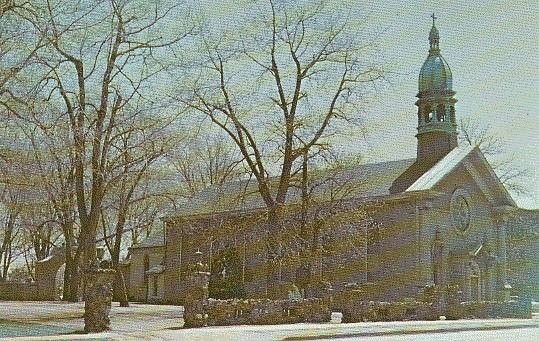Our Lady Help of Christians Chapel
Introduction
Text-to-speech Audio
Originally built in 1853, Our Lady Help of Christians Chapel is a historic church that became a religious center for immigrants from the Alsace-Lorraine region in eastern France and as a pilgrimage site for Alsatians and other European Catholic immigrants. The chapel is just south of the modern church building. In terms of architecture, the chapel features a Greek Revival exterior and an Alsatian interior with arched windows, a barrel vaulted ceiling, and frescos. This combination allowed to church to appear American from the outside but like Alsatian village church from the inside. The grounds include a cemetery, the former school building, and a shrine. The chapel was listed on the National Register of Historic Places December 14, 1978.
Images
Our Lady Help of Christians was built originally built in 1853 and soon became a pilgrimage site for European Catholic immigrants soon after it was completed.

Backstory and Context
Text-to-speech Audio
Alsatian immigrant Joseph Batt built the chapel in 1853, fulfilling a vow he made nearly twenty years earlier on November 29, 1836. On October 20, he and his family left the Alsace-Lorraine to begin their journey America. On November 29, the ship they sailed on, The Mary Ann, got caught in a hurricane in the North Atlantic that damaged the ship. Batt prayed to Mary, invoking one of her titles, Our Lady Help of Christians, to protect the ship and his family. In return, he promised to build a chapel. The storm died down and the ship drifted to Ireland where it was repaired.
Batt and his family finally reached America on February 2, 1837. He never forgot his vow but had to wait until he was fully settled and financially able to build the chapel. News of the chapel and Batt's story spread quickly and pilgrims from the Cheektowaga area soon came to pay homage to Mary. However, it was not officially declared as a pilgrimage site until 1864. In the coming years, Italian and Polish immigrants arrived in the area and the chapel played a large role in helping them assimilate into the largely German-speaking community (although the Alsace-Lorraine is now a part of France, many residents speak German, specifically the German dialect Alsatian).
In 1871, the nave was added that enlarged the building significantly. The chapel was expanded for the third and final time in 1926 and the interior was renovated as well. These later additions and alterations represent the ethnic diversity of the chapel and the pilgrimage. For example, the Italian influence is visible in the Italian Renaissance porch and the statues of Saint Stanislaus and the Hungarian Infant of Prague (both are inside the chapel) reflect the Polish influence. The chapel was restored in 2000.
Sources
Batt, Dr. Ronald E. & Ross, Claire L. "Chapel of Our Lady Help of Christians." National Park Service - National Register of Historic Places Nomination Form. December 14, 1978. https://s3.amazonaws.com/NARAprodstorage/lz/electronic-records/rg-079/NPS_NY/78001851.pdf.
"Our Lady Help of Christians." Our Lady Help of Christians. Accessed July 11, 2022. https://www.ourladyhelpofchristians.org/our-historic-chapel.html.
Our Lady Help of Christians
